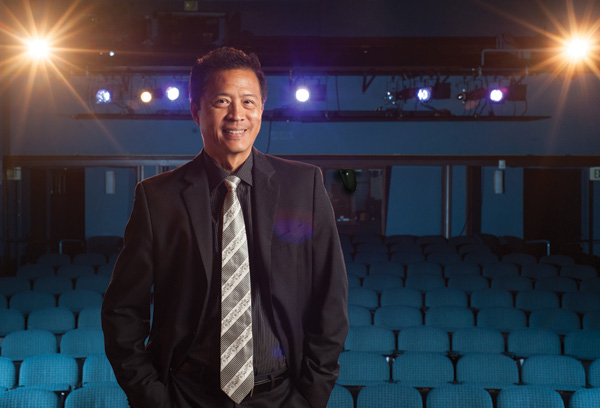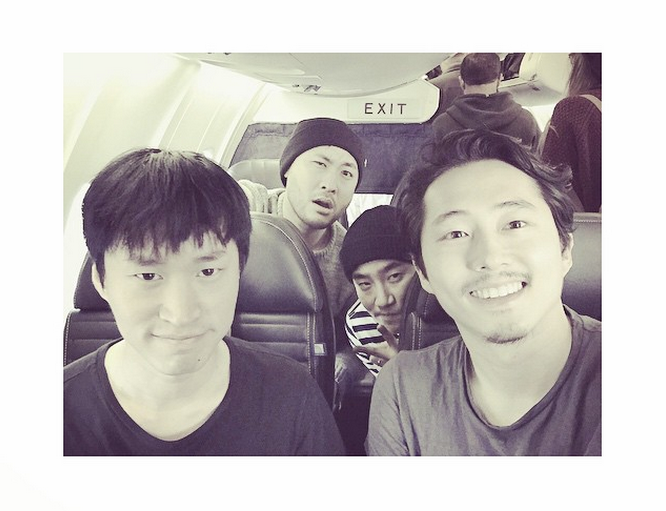Pictured above: Tim Dang, producing artistic director of East West Players. (Photo courtesy of M. Palma Photography)
by ADA TSENG
Tucked inside the Union Center for the Arts in Los Angeles’ Little Tokyo District sits the David Henry Hwang Theater, home to East West Players, the country’s first Asian American theatre organization that is celebrating a milestone 50th year.
A lot of history has been made at East West Players, as the framed posters lining the wall by the theater’s interior staircase illustrate. There’s one of Hwang’s 1988 Tony Award-winning M. Butterfly, revived in 2004; a 2000 production of My Tired Broke Ass Pontificating Slapstick Funk starring John Cho; and actor George Takei in a 2005 production of Equus.
Those who grew up with East West Players know that the posters only tell part of the story.
Decades before the theater would be named after him, Hwang spent much of his childhood hanging around rehearsals, since his father did the company’s accounting and his pianist mother provided musical accompaniment. Takei’s portrayal of a tortured psychiatrist in Equus partly inspired his decision to come out publicly as gay. And Cho’s onstage love interest in My Tired Broke Ass Pontificating Slapstick Funk, an “anti-romantic” comedy by Korean American playwright Euijoon Kim, was played by none other than Cho’s future wife, actress Kerri Higuchi.
The esteemed company has always been more than just a showcase for art and emerging talent—it’s created 50 years of community.
 East West players’ very first production, Rashomon.
East West players’ very first production, Rashomon.
Nearly 15 years ago, “you really couldn’t be an Asian American actor without having something to do with East West Players,” remembers Stefanie Wong Lau, the company’s former marketing director who went on to co-found Artists at Play, an independent Asian American theatre company. “I can’t count how many times [Asian Americans] would contact us and say, ‘I just moved here, and I was told I need to come by and meet people.’”
Consider that more than 75 percent of Asian American and Pacific Islanders in acting unions in Los Angeles had worked at East West Players, according to a 2006 interview Tim Dang, the company’s current producing artistic director, gave the Los Angeles Times.
Indeed, its alumni consists of a notable roster of Asian Americans, including many Korean Americans, such as Daniel Dae Kim, James Kyson, Ki Hong Lee, Jacqueline Kim and C.S. Lee, who recently returned to the stage to perform Animals Out of Paper, Pulitzer Prize-finalist Rajiv Joseph’s play about a world-renowned origami artist.
Today, East West Players has the distinction of being the longest-running professional theater of color in the U.S. Back in 1965, a group of nine Asian American artists, frustrated with the lack of non-stereotypical roles for Asian Americans in Hollywood and influenced by the American Civil Rights movement, formed the troupe, holding rehearsals in the Bethany Presbyterian Church in L.A.’s Silver Lake district. There were few Asian American playwrights at the time, so the company staged European and Japanese works (its very first production was Ryunosuke Akutagawa’s Rashomon, the source material for the award-winning 1950 Akira Kurosawa film).
It wasn’t until the 1970s—the company had moved into a 99-seat black box theater in Hollywood by then—that developing original works by Asian American playwrights became a tangible goal. Korean American founding member Soon-Tek Oh penned the first original productions, including Martyrs Can’t Go Home, a play about the Korean War.
In 1998, East West Players moved into the 240-seat mid-sized equity house where it is based today. It boasts an average 10,000 audience visits per year and annually produces a full season of original Asian American works, as well as re-stagings of plays and musicals. Its 50th anniversary season, currently underway, included the world premiere of intercultural comedy Washer/Dryer and The Who’s Tommy, a classic rock musical based on The Who’s 1969 double album rock opera which opens May 7.
Many veterans of East West Players have gone on to form niche production companies, including Cold Tofu, a comedy improv and sketch group; here-and-now theatre company; Lodestone Theatre Ensemble, which spun out of Oh’s Society of Heritage Performers, a Korean American ensemble that staged provocative works dealing with themes of sex, drugs, violence and religion; and Artists at Play. Since 2011, the latter has specialized in bringing to Los Angeles Asian American plays that have already found success around the nation.
East West Players’ reputation as the premier Asian American theater in the country is built on a long legacy, and one of its challenges has been persuading the broader theater community to let go of the boundaries separating “ethnic” theater from “mainstream American” theater.
Though crossover productions exist, including Allegiance, a musical starring Takei about Japanese Americans in U.S. internment camps set to open on Broadway later this year, Dang feels there is still a long way to go before mainstream theater begins to truly reflect the experience of people of color—who, by 2042, are expected to outnumber non-Hispanic whites. Dang recently launched a diversity initiative called “The 51% Preparedness Plan,” which challenges mainstream theaters to diversify their personnel to include 51 percent women, youth or minorities over the next five years.
 Daniel Dae Kim in Golden Child.
Daniel Dae Kim in Golden Child.
“I think TV and film are getting the message really quickly and starting to have a lot more people of color onscreen,” Dang says. “They’re realizing this is the way they need to do business now. But theater is behind the curve.”
Another challenge to the established theater group is the fact that young Asian American talent, plus their audiences, is increasingly flocking to the digital medium.
Over the last several years, many theaters whose mission was to promote Asian American artists and storytellers have either scaled back operations or shut down completely. Thus, for a company that created the Asian American theater scene five decades ago and continues to lead it, seeking new ways to stay relevant and attract new audience members is a priority.
For example, while the leads in Washer/Dryer were Indian American and Chinese American, the supporting roles included a Caucasian neighbor and a gay African American best friend. In its casting call for The Who’s Tommy, East West Players sought out Latinos, Middle Eastern Americans and Native Americans.
“We need to practice what we preach,” Dang says. “And that means we have to open up and be more inclusive. There will still be an emphasis on Asian Americans, but Asian Americans don’t live in a vacuum.
“I’m on the tail end of the Baby Boomer generation, so it was a big thing to be proud to be Asian because we were so invisible,” Dang adds. “But if you talk to the younger generation, the thinking is different. They are individuals of many intersections. And I’m happy to see that we’ve progressed in a way that Asian Americans are comfortable being part of the [greater American] community.”
___
All production stills courtesy of East West Players
This article was published in the April/May 2015 issue of KoreAm. Subscribe today! To purchase a single issue copy of the April/May issue, click the “Buy Now” button below. (U.S. customers only. Expect delivery in 5-7 business days).






